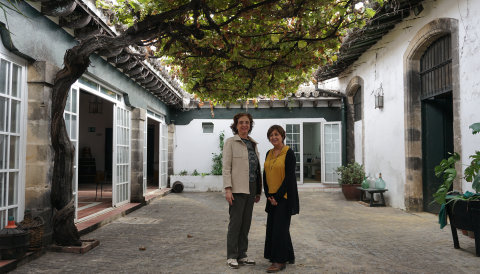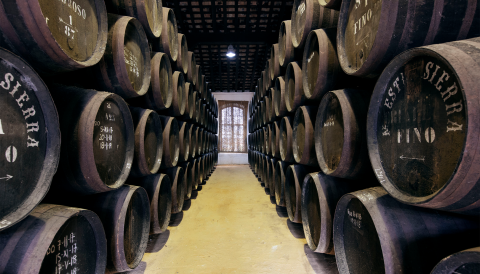From €21.21, £20.50, CA$39.89, $34.99, AU$65.99
It was only 11 am on Monday morning but it felt like a full-fledged party in the crowded room off the foyer of the Hotel Chelsea in Manhattan. That’s what happens when you gather more than 30 of the top names in Jerez, all pouring a selection of their wines, to crowds of flor-loving wine geeks. It was the first day of Sherry Week, and it set the tone well for the coming seven days.
This celebration, now in its 10th year, was created to address what César Saldaña refers to in his exceptionally useful new Book of Sherry Wines as sherry’s difficulty with its conversion rate. ‘Few wines are so well known to the public, yet with such a small number of regular consumers’, he writes.
He chalks it up to the intricacies of Sherry – ‘an authentic nightmare for even the most talented marketing guru’ – while pointing out that ‘it is this very complexity … that makes it so extraordinarily attractive, especially among lovers of good wine’. Those complexities were on full display in this tasting, with wines ranging from the unfortified Palominos of Territorio Albariza (see more on these eye-opening wines in Jancis’s recent story, Sherry’s saviour?); the sharp Manzanillas from La Guita and chamomile-drenched Aurora version; the gentle Sánchez Romates and the fruity Buelan Compañía de Sacas; the delicate sherries of Bodegas Tradición and the full-throated versions from César Florido (especially the mahogany-hued Moscatel Pasas, a sweet wine so round and smooth and otherworldly that it felt like drinking marbles on the moon).
And that was only half of it.
But the wine that stayed with me the entire day, the one I could close my eyes and taste even later at my desk; in the din of a crowded subway station; in the chaos of evening chores and homework help, was El Maestro Sierra’s Anticuario Amontillado 1830.
This is not the wine I’m recommending as the Wine of the Week, as it’s far too rare and expensive to fit the bill. But knowing about it will illuminate why this house is so special, and why you will want to search out the ‘normal’ Amontillado 12 Años (12 years old), which echoes the complexity of its older relative but is a fraction of the price.
The Anticuario comes from a cask that’s nearly as old as the estate, which was founded in 1830, and was made by the founder, José Antonio Sierra, a master cooper. Sierra’s barrels were sought after by all the major houses, and the industry wasn’t very happy when he decided to keep them for his own wines; the house’s classic wine label, showing a hare pursued by a pack of dogs and a hunter on horseback, is a nod to his perseverance.
Since Sierra’s death, the house has been run largely by women – a rarity everywhere in the 1900s but especially so in Jerez – first passing to Sierra’s wife’s niece, then, after a short spell under her son, passing into the hands of his wife, Pilar Plá, in 1976.
Pilar was tenacious in keeping the estate going, supporting the estate with savvy and extremely limited sales of wines to top bodegas. (At one point, Lustau was bottling an Almencenista Oloroso Viuda de Antonio Borrego.) She also made the crucial step of deciding to bottle their own wines rather than selling them to bottlers, in 1992.
Pilar died in 2020 at the age of 99 but her daughter Mari Carmen Borrego Plá runs it with the same fierce dedication as her mother, accompanied by Ana Cabestrero, the capataza, or master blender, who’s been with Maestro Sierra since 2003.
Cabestrero, who originally hails from Ribera del Duero, has maintained the traditional ways of working, engaging a museum’s worth of old hand tools, and working with their own in-house cooper to maintain the barrels. No new barrels are used, ever, and nothing is added to the wines, not even any sulphites, so as not to disturb the careful equilibrium in the house. Situated on a breezy bluff in Jerez, the house was built to channel the sea breezes as well as the humidity, which they encourage by regular watering-down of the floors, which are comprised of albero, a sort of sandy clay that holds moisture well.
It’s because of this privileged position, and because of the women who’ve tended the casks so carefully, that El Maestro Sierra can boast soleras that date back to the bodega’s founding. Unfortunately, as Steven Alexander at De Maison Selections, El Maestro’s US importer, explained in an email to me, sometimes things do go wrong: in 2017, Cabestrero discovered a slow leak in an old two-cask solera. ‘They had to drain the barrel into another cask to save the precious, historic liquid inside, so that they could repair the barrel and save their prized solera which dates to the founding of the winery in 1830’, he wrote. ‘Protecting the integrity and average age of the solera was of paramount importance to Ana, so in 2017 she bottled 75 magnums by hand, directly from cask, and shut down the solera for commercial purposes for a few years, while the solera settled from moving the wine that had never before been disturbed by racking.’
That bad luck is the extremely good luck of anyone lucky enough to taste the wine from one of those magnums. It’s a wine that can send you hurtling back through centuries in a single whiff. There’s the smell of the sea, of sand and kelp and briny tide pools; there’s the hint of the wine’s life under flor in its marmite richness, and of its life after flor, in oxidative notes of hazelnuts and honey all wrapped in spice. There’s a sense of sun and heat in its intensity and concentration, and of time in the way it slowly plays its kaleidoscopic detail out. It feels as though the wine has taken notes on every year of its being. And yet it also could not be more energetic, more alive. This is not a remnant of history, but an active participant in it.
But if the magnum is out of reach, the Amontillado 12 Años will do just fine. The wine inside may be a fraction of its age, but it’s still older than most Amontillados on the market, and has that much more complexity because of it. What’s more, it also captures an essence of the estate in its sense of time and energy, the push-pull of honeyed hazelnut richness and breezy salinity, and in the combination of elegance and strength that defines this small but mighty estate.
In the US, El Maestro Sierra wines are imported by DeMaison Selections, which has a small stock of the Anticuario Amontillado 1830 ($178/375 ml, $1,113/1,500 ml) and carries the 12 Años ($40/375 ml); in the UK, Indigo Wine distributes the wines and sells them through their retail arm, The Sourcing Table (£20.50/375 ml for the 12 Años).
For more ideas on wines to drink during Sherry Week, members can access hundreds of sherry recommendations in our tasting notes database.

















